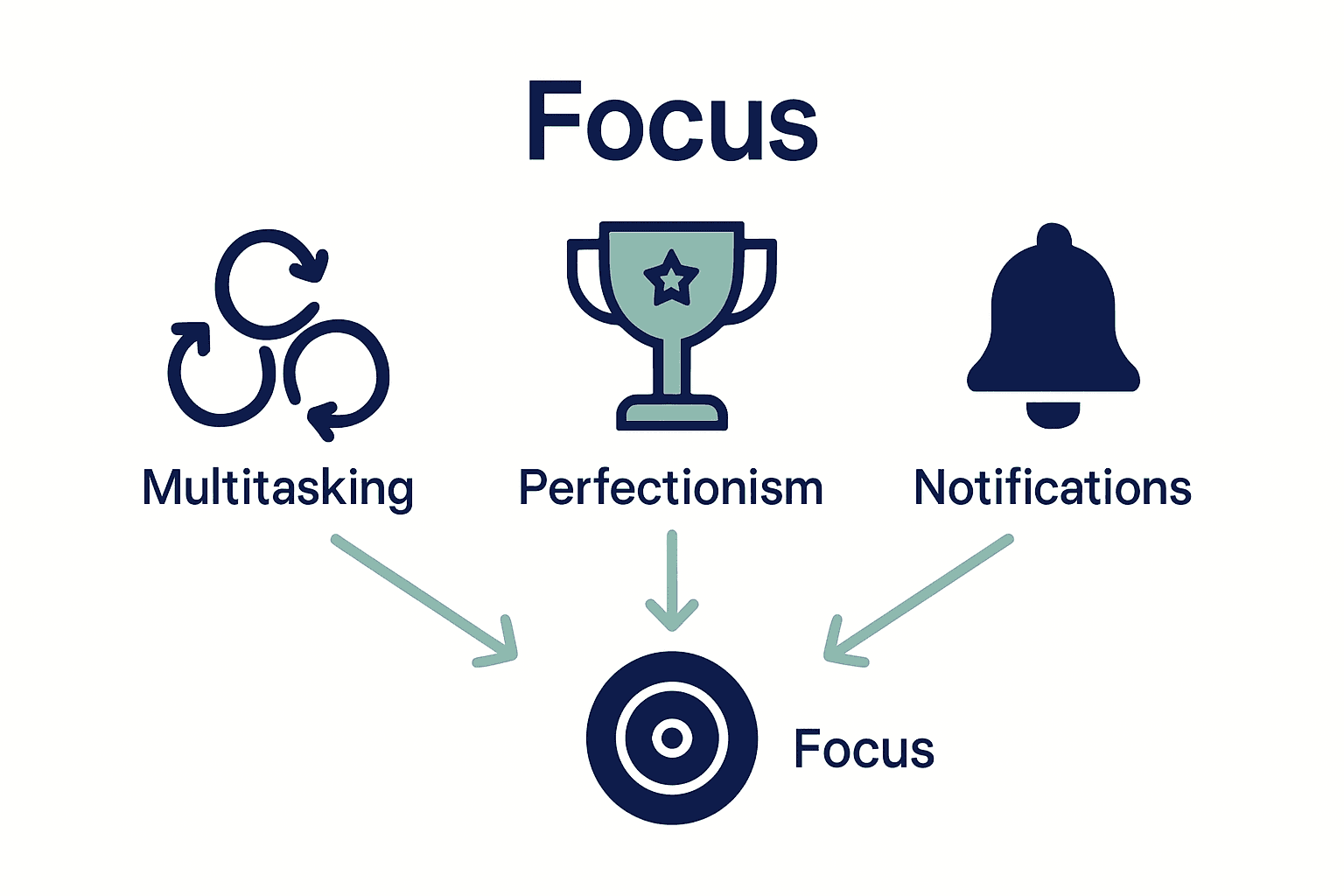Did you know that nearly 80 percent of workers admit to wasting time on the job every day? Office productivity is a major concern for professionals who want to get more done without burning out. Between trendy hacks, popular myths, and ever-changing workplace tools, it can be easy to confuse busyness for true progress. Understanding what actually works can make a real difference in your efficiency, results, and job satisfaction.
Key Takeaways
| Point | Details |
|---|---|
| Embrace Smart Work, Not Busy Work | Productivity hacks focus on working smarter through intentional actions and avoiding productivity theater. Prioritize results over the appearance of busyness. |
| Customize Your Productivity Strategies | Different productivity hacks suit various individuals; experiment with time management, technological, and psychological approaches for optimal results. |
| Optimize Your Workflow | Implement clear communication, standardized processes, and reduce unnecessary meetings to enhance efficiency across teams. |
| Recognize and Avoid Pitfalls | Be aware of productivity traps like multitasking and perfectionism, which can hinder performance; focus on quality and self-awareness instead. |
Table of Contents
- Defining Office Productivity Hacks And Myths
- Top Types Of Productivity Hacks Explained
- Improving Workflow With Smart Practices
- Workspace Upgrades: Tools And Technology
- Avoiding Common Productivity Pitfalls
Defining Office Productivity Hacks and Myths
When we talk about productivity hacks, we’re diving into more than just clever shortcuts. According to Wikipedia’s history of life hacks, this concept emerged in 2004 as a way to describe ingenious tricks that transform complex problems into simple solutions. But not all productivity strategies are created equal.
At its core, a productivity hack isn’t about working harder—it’s about working smarter. These strategies range from technological tools to psychological techniques that help professionals optimize their workflow. However, professionals must be cautious about falling into the trap of productivity theater, a phenomenon where actions look productive but generate minimal actual results.
Some common productivity myths include:
- Multitasking increases efficiency
- Working longer hours means more output
- Productivity is solely about individual performance
Reality tells a different story. According to research on productivity theater, many behaviors that seem efficient actually drain energy and reduce genuine work output. Successful professionals understand that true productivity isn’t about appearing busy, but about creating meaningful progress through strategic approaches and smart work management.
The most effective productivity strategies focus on intentional actions, clear priorities, and systems that support consistent performance—not theatrical displays of busyness.
Top Types of Productivity Hacks Explained
Productivity hacks aren’t one-size-fits-all solutions. They’re strategic approaches designed to help professionals maximize their time, energy, and focus across different aspects of work and personal performance. Time management and workflow optimization represent two fundamental categories that can dramatically transform how teams and individuals approach their daily responsibilities.
Let’s break down the most impactful productivity hack types:
Time Management Hacks
- Pomodoro Technique: Breaking work into 25-minute focused intervals
- Time blocking: Scheduling specific tasks in dedicated time slots
- Prioritization frameworks like Eisenhower Matrix
Technological Productivity Hacks
- Automation tools for repetitive tasks
- Project management software integrations
- Communication platform streamlining
Psychological and Mental Performance Hacks
- Mindfulness and meditation practices
- Energy management instead of time management
- Habit formation and routine development
Each productivity hack type addresses different challenges. Time management hacks help combat procrastination and improve focus. Technological hacks reduce manual work and create seamless workflows. Psychological hacks enhance mental resilience and sustainable performance.
Here’s a summary of the main productivity hack types:
| Hack Type | Key Examples | Primary Benefit |
|---|---|---|
| Time Management | Pomodoro Technique Time blocking Eisenhower Matrix |
Improves focus and prioritizes tasks |
| Technological | Automation tools Project management software Communication integration |
Reduces manual work and streamlines workflows |
| Psychological | Mindfulness Energy management Habit formation |
Boosts mental resilience and sustainable performance |
Successful professionals blend these approaches, creating personalized productivity systems that adapt to their unique work styles and organizational demands. The key is experimentation and continuous refinement—what works brilliantly for one person might need adjustment for another.
Improving Workflow With Smart Practices
Smart workflow practices are not about working harder, but creating intelligent systems that maximize efficiency and reduce unnecessary friction. Workflow optimization is a strategic approach that transforms how professionals manage tasks, collaborate, and maintain consistent performance across complex work environments.
Key Workflow Enhancement Strategies
- Implement clear communication protocols
- Develop standardized process documentation
- Create repeatable task management systems
- Minimize unnecessary meeting times
- Establish transparent accountability mechanisms
Understanding workflow dynamics requires recognizing that productivity isn’t about constant motion, but purposeful action. Successful teams develop adaptive workflow frameworks that allow flexibility while maintaining structured approaches. This means creating systems that can adjust to changing project demands without losing core organizational momentum.
Technological integration plays a critical role in modern workflow optimization. Smart professionals leverage digital tools that automate routine tasks, provide real-time collaboration features, and generate actionable performance insights. Project management platforms, communication tools, and integrated software ecosystems enable teams to streamline complex workflows with unprecedented precision.
Ultimately, improving workflow is an ongoing process of observation, experimentation, and refinement. No single approach works universally. The most effective workflow practices emerge from understanding your team’s unique dynamics, technological capabilities, and performance goals. Continuous learning, open communication, and a willingness to modify existing systems are the true hallmarks of workflow excellence.

Workspace Upgrades: Tools And Technology
Modern workspaces are evolving beyond traditional setups, integrating smart technologies that transform how professionals interact with their environment. These upgrades go far beyond simple gadgets—they represent a comprehensive approach to creating more efficient, comfortable, and adaptive work environments that support peak human performance.
Key Technological Workspace Upgrades
-
Ergonomic Equipment
- Adjustable standing desks
- Ergonomic chairs with posture support
- Keyboard and mouse designs that reduce strain
Digital Infrastructure Enhancements
- Cloud-based collaboration platforms
- High-speed wireless networks
- Integrated communication systems
- Noise-canceling technologies
Digital tools have become the backbone of modern workspace productivity. Smart professionals recognize that technology is not just about having the latest devices, but about creating seamless ecosystems that enhance collaboration, reduce friction, and support individual work styles. This means selecting tools that integrate smoothly, provide real-time communication, and adapt to changing work dynamics.
Ergonomic considerations are equally critical in workspace technology. Intelligent workspace design goes beyond aesthetic considerations, focusing on human-centric technologies that support physical health, mental well-being, and sustained performance. From height-adjustable workstations that encourage movement to ambient lighting systems that reduce eye strain, these upgrades represent a holistic approach to workplace technology.
The most effective workspace technologies are those that feel invisible—tools so well-integrated that they become natural extensions of human capability. As remote and hybrid work models continue to evolve, investing in smart workspace technologies is no longer a luxury, but a strategic necessity for organizations seeking to attract top talent and maintain competitive edge.
Avoiding Common Productivity Pitfalls
Productivity traps are subtle obstacles that can derail even the most well-intentioned professionals. These hidden challenges emerge not from a lack of effort, but from misguided strategies that seem productive on the surface but ultimately undermine genuine performance and well-being.
Most Critical Productivity Pitfalls
- Chronic multitasking
- Perfectionism paralysis
- Constant email and notification checking
- Neglecting personal energy management
- Failing to set clear boundaries
Understanding these pitfalls requires a fundamental shift in perspective. Effective productivity isn’t about doing more, but about creating systems that allow you to focus on what truly matters. Many professionals mistakenly believe that constant activity equals meaningful progress, when in reality, this approach leads to burnout and diminished overall performance.
Psychological barriers play a significant role in productivity challenges. Perfectionism, for instance, can create massive mental roadblocks that prevent professionals from starting or completing important tasks. Similarly, the illusion of multitasking—which scientific research consistently proves is a myth—leads to fragmented attention and reduced cognitive performance. Smart professionals learn to create focused work environments that minimize distractions and prioritize deep, meaningful work.
The most powerful productivity strategy is self-awareness. This means understanding your personal energy cycles, recognizing your genuine limitations, and designing work systems that complement your natural rhythm. It’s about quality over quantity, strategic focus over constant motion. By identifying and systematically eliminating productivity pitfalls, professionals can create more meaningful, sustainable, and enjoyable work experiences that drive real results.

Transform Your Workspace for Real Productivity Gains
You have already learned in this guide that true office productivity depends on workflow optimization, intentional focus, and smart workspace improvements. Yet many businesses overlook a simple factor with a powerful impact: the physical environment where teams perform their best work. Cluttered or uncomfortable workspaces lead to hidden productivity pitfalls like fatigue, distractions and preventable injuries—undermining even the smartest time management strategies or digital hacks.
Upgrade your office for maximum efficiency with durable, ergonomic floor mat solutions from Mats4U.com. Discover options that support standing desk use, help reduce slip hazards, and minimize workplace fatigue. Ready to boost your team’s performance and create a workspace that complements your workflow optimization efforts? Visit Mats4U.com now to explore easy online selection tools and get free delivery on qualifying orders. Take the next step toward a smarter, more productive office environment today.
Frequently Asked Questions
What are the most effective productivity hacks for businesses?
The most effective productivity hacks for businesses include implementing time management techniques like the Pomodoro Technique and time blocking, utilizing technological tools for automation and project management, and adopting psychological strategies such as mindfulness practices.
How can I improve my team’s workflow effectively?
Improving your team’s workflow can be achieved by establishing clear communication protocols, creating standardized process documentation, minimizing unnecessary meetings, and utilizing task management systems that promote accountability and transparency.
What are common productivity pitfalls to avoid?
Common productivity pitfalls include chronic multitasking, perfectionism, constant checking of emails and notifications, and neglecting personal energy management. Being aware of these pitfalls can help create a more focused and efficient working environment.
How do workspace upgrades impact productivity?
Workspace upgrades, such as ergonomic equipment and enhanced digital infrastructure, significantly impact productivity by promoting comfort, reducing strain, and facilitating seamless collaboration. Effective workspace technologies create an environment that supports sustained performance and employee well-being.
Recommended
- Understanding Current Office Design Trends for 2023 – Mats4U USA
- Understanding Ergonomics in the Workplace – Mats4U USA
- Understanding Sustainable Workplace Practices for Business Success – Mats4U USA
- Understanding Reducing Workplace Stress: Key Concepts – Mats4U USA
- Effective Business Communication: Complete Guide for Ontario - My Mobile Notary
- A Beginner’s Guide to Agile Methodologies for Success - Berriault and Associates Consulting Group







